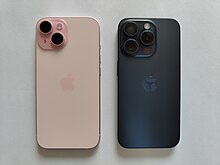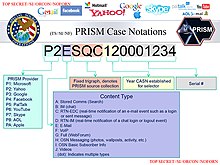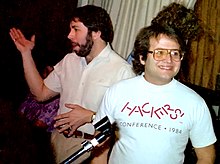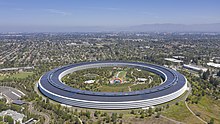Apple Computer
The company was founded to produce and market Wozniak's Apple I personal computer. Its second computer, the Apple II, became a best seller as one of the first mass-produced microcomputers. Apple introduced the Lisa in 1983 and the Macintosh in 1984, as some of the first computers to use a graphical user interface and a mouse. By 1985, internal company problems led to Jobs leaving to form NeXT, Inc., and Wozniak withdrawing to other ventures; John Sculley served as long-time CEO for over a decade. In the 1990s, Apple lost considerable market share in the personal computer industry to the lower-priced Wintel duopoly of the Microsoft Windows operating system on Intel-powered PC clones. In 1997, Apple was weeks away from bankruptcy. To resolve its failed operating system strategy, it bought NeXT, effectively bringing Jobs back to the company, who guided Apple back to profitability over the next decade with the introductions of the iMac, iPod, iPhone, and iPad devices to critical acclaim as well as the iTunes Store, launching the "Think different" advertising campaign, and opening the Apple Store retail chain. These moves elevated Apple to consistently be one of the world's most valuable brands since about 2010. Jobs resigned in 2011 for health reasons, and died two months later; he was succeeded as CEO by Tim Cook.
Apple's current product lineup includes portable and home hardware such as the iPhone, iPad, Apple Watch, Mac, and Apple TV; operating systems such as iOS, iPadOS, and macOS; and various software and services including Apple Pay, iCloud, and multimedia streaming services like Apple Music and Apple TV+. Apple is one of the Big Five American information technology companies; for the most part since 2011, Apple has been the world's largest company by market capitalization, and, as of 2023, is the largest manufacturing company by revenue, the fourth-largest personal computer vendor by unit sales, the largest vendor of tablet computers, and the largest vendor of mobile phones in the world. Apple became the first publicly traded U.S. company to be valued at over $1 trillion in 2018, and, as of December 2024, is valued at just over $3.74 trillion.
Apple has received criticism regarding its contractors' labor practices, its relationship with trade unions, its environmental practices, and its business ethics, including anti-competitive practices and materials sourcing. Nevertheless, the company has a large following and enjoys a high level of brand loyalty.
History
1976–1980: Founding and incorporation


Apple Computer Company was founded on April 1, 1976, by Steve Jobs, Steve Wozniak, and Ronald Wayne as a partnership. The company's first product is the Apple I, a computer designed and hand-built entirely by Wozniak. To finance its creation, Jobs sold his Volkswagen Bus, and Wozniak sold his HP-65 calculator. Neither received the full selling price but in total earned $1,300 (equivalent to $7,000 in 2023). Wozniak debuted the first prototype Apple I at the Homebrew Computer Club in July 1976. The Apple I was sold as a motherboard with CPU, RAM, and basic textual-video chips—a base kit concept which was not yet marketed as a complete personal computer. It was priced soon after debut for $666.66 (equivalent to $3,600 in 2023). Wozniak later said he was unaware of the coincidental mark of the beast in the number 666, and that he came up with the price because he liked "repeating digits".
Apple Computer, Inc. was incorporated in Cupertino, California, on January 3, 1977, without Wayne, who had left and sold his share of the company back to Jobs and Wozniak for $800 only twelve days after having co-founded it. Multimillionaire Mike Markkula provided essential business expertise and funding of $250,000 (equivalent to $1,257,000 in 2023) to Jobs and Wozniak during the incorporation of Apple. During the first five years of operations, revenues grew exponentially, doubling about every four months. Between September 1977 and September 1980, yearly sales grew from $775,000 to US$118 million, an average annual growth rate of 533%.
The Apple II, also designed by Wozniak, was introduced on April 16, 1977, at the first West Coast Computer Faire. It differs from its major rivals, the TRS-80 and Commodore PET, because of its character cell-based color graphics and open architecture. The Apple I and early Apple II models use ordinary audio cassette tapes as storage devices, which were superseded by the 5+1⁄4-inch floppy disk drive and interface called the Disk II in 1978.

The Apple II was chosen to be the desktop platform for the first killer application of the business world: VisiCalc, a spreadsheet program released in 1979. VisiCalc created a business market for the Apple II and gave home users an additional reason to buy an Apple II: compatibility with the office, but Apple II market share remained behind home computers made by competitors such as Atari, Commodore, and Tandy.
On December 12, 1980, Apple (ticker symbol "AAPL") went public selling 4.6 million shares at $22 per share ($.10 per share when adjusting for stock splits as of September 3, 2022), generating over $100 million, which was more capital than any IPO since Ford Motor Company in 1956. By the end of the day, around 300 millionaires were created, including Jobs and Wozniak, from a stock price of $29 per share and a market cap of $1.778 billion.
1980–1990: Success with Macintosh

In December 1979, Steve Jobs and Apple employees, including Jef Raskin, visited Xerox PARC, where they observed the Xerox Alto, featuring a graphical user interface (GUI). Apple subsequently negotiated access to PARC's technology, leading to Apple's option to buy shares at a preferential rate. This visit influenced Jobs to implement a GUI in Apple's products, starting with the Apple Lisa. Despite being pioneering as a mass-marketed GUI computer, the Lisa suffered from high costs and limited software options, leading to commercial failure.
Jobs, angered by being pushed off the Lisa team, took over the company's Macintosh division. Wozniak and Raskin had envisioned the Macintosh as a low-cost computer with a text-based interface like the Apple II, but a plane crash in 1981 forced Wozniak to step back from the project. Jobs quickly redefined the Macintosh as a graphical system that would be cheaper than the Lisa, undercutting his former division. Jobs was also hostile to the Apple II division, which at the time, generated most of the company's revenue.
In 1984, Apple launched the Macintosh, the first personal computer without a bundled programming language. Its debut was signified by "1984", a US$1.5 million television advertisement directed by Ridley Scott that aired during the third quarter of Super Bowl XVIII on January 22, 1984. This was hailed as a watershed event for Apple's success and was called a "masterpiece" by CNN and one of the greatest TV advertisements of all time by TV Guide.
The advertisement created great interest in Macintosh, and sales were initially good, but began to taper off dramatically after the first three months as reviews started to come in. Jobs had required 128 kilobytes of RAM, which limited its speed and software in favor of aspiring for a projected price point of $1,000 (equivalent to $2,900 in 2023). The Macintosh shipped for $2,495 (equivalent to $7,300 in 2023), a price panned by critics due to its slow performance. In early 1985, this sales slump triggered a power struggle between Steve Jobs and CEO John Sculley, who had been hired away from Pepsi two years earlier by Jobs saying, "Do you want to sell sugar water for the rest of your life or come with me and change the world?" Sculley removed Jobs as the head of the Macintosh division, with unanimous support from the Apple board of directors.
The board of directors instructed Sculley to contain Jobs and his ability to launch expensive forays into untested products. Rather than submit to Sculley's direction, Jobs attempted to oust him from leadership. Jean-Louis Gassée informed Sculley that Jobs had been attempting to organize a boardroom coup and called an emergency meeting at which Apple's executive staff sided with Sculley and stripped Jobs of all operational duties. Jobs resigned from Apple in September 1985 and took several Apple employees with him to found NeXT. Wozniak had also quit his active employment at Apple earlier in 1985 to pursue other ventures, expressing his frustration with Apple's treatment of the Apple II division and stating that the company had "been going in the wrong direction for the last five years". Wozniak remained employed by Apple as a representative, receiving a stipend estimated to be $120,000 per year. Jobs and Wozniak remained Apple shareholders following their departures.
After the departures of Jobs and Wozniak in 1985, Sculley launched the Macintosh 512K that year with quadruple the RAM, and introduced the LaserWriter, the first reasonably priced PostScript laser printer. PageMaker, an early desktop publishing application taking advantage of the PostScript language, was also released by Aldus Corporation in July 1985. It has been suggested that the combination of Macintosh, LaserWriter, and PageMaker was responsible for the creation of the desktop publishing market.
This dominant position in the desktop publishing market allowed the company to focus on higher price points, the so-called "high-right policy" named for the position on a chart of price vs. profits. Newer models selling at higher price points offered higher profit margin, and appeared to have no effect on total sales as power users snapped up every increase in speed. Although some worried about pricing themselves out of the market, the high-right policy was in full force by the mid-1980s, due to Jean-Louis Gassée's slogan of "fifty-five or die", referring to the 55% profit margins of the Macintosh II.
This policy began to backfire late in the decade as desktop publishing programs appeared on IBM PC compatibles with some of the same functionality of the Macintosh at far lower price points. The company lost its dominant position in the desktop publishing market and estranged many of its original consumer customer base who could no longer afford Apple products. The Christmas season of 1989 was the first in the company's history to have declining sales, which led to a 20% drop in Apple's stock price. During this period, the relationship between Sculley and Gassée deteriorated, leading Sculley to effectively demote Gassée in January 1990 by appointing Michael Spindler as the chief operating officer. Gassée left the company later that year to set up a rival, Be Inc.
1990–1997: Decline and restructuring

The company pivoted strategy and, in October 1990, introduced three lower-cost models: the Macintosh Classic, the Macintosh LC, and the Macintosh IIsi, all of which generated significant sales due to pent-up demand. In 1991, Apple introduced the hugely successful PowerBook with a design that set the current shape for almost all modern laptops. The same year, Apple introduced System 7, a major upgrade to the Macintosh operating system, adding color to the interface and introducing new networking capabilities.
The success of the lower-cost Macs and PowerBook brought increasing revenue. For some time, Apple was doing very well, introducing fresh new products at increasing profits. The magazine MacAddict named the period between 1989 and 1991 as the "first golden age" of the Macintosh.

The success of lower-cost consumer Macs, especially the LC, cannibalized higher-priced machines. To address this, management introduced several new brands, selling largely identical machines at different price points, for different markets: the high-end Quadra series, the mid-range Centris series, and the consumer-marketed Performa series. This led to significant consumer confusion between so many models.
In 1993, the Apple II series was discontinued. It was expensive to produce, and the company decided it was still absorbing sales from lower-cost Macintosh models. After the launch of the LC, Apple encouraged developers to create applications for Macintosh rather than Apple II, and authorized salespersons to redirect consumers from Apple II and toward Macintosh. The Apple IIe was discontinued in 1993.
Apple experimented with several other unsuccessful consumer targeted products during the 1990s, including QuickTake digital cameras, PowerCD portable CD audio players, speakers, the Pippin video game console, the eWorld online service, and Apple Interactive Television Box. Enormous resources were invested in the problematic Newton tablet division, based on John Sculley's unrealistic market forecasts.
Throughout this period, Microsoft continued to gain market share with Windows by focusing on delivering software to inexpensive personal computers, while Apple was delivering a richly engineered but expensive experience. Apple relied on high profit margins and never developed a clear response; it sued Microsoft for making a GUI similar to the Lisa in Apple Computer, Inc. v. Microsoft Corp. The lawsuit dragged on for years and was finally dismissed. The major product flops and the rapid loss of market share to Windows sullied Apple's reputation, and in 1993 Sculley was replaced as CEO by Michael Spindler.

Under Spindler, Apple, IBM, and Motorola formed the AIM alliance in 1994 to create a new computing platform (the PowerPC Reference Platform or PReP), with IBM and Motorola hardware coupled with Apple software. The AIM alliance hoped that PReP's performance and Apple's software would leave the PC far behind and thus counter the dominance of Windows. That year, Apple introduced the Power Macintosh, the first of many computers with Motorola's PowerPC processor.
In the wake of the alliance, Apple opened up to the idea of allowing Motorola and other companies to build Macintosh clones. Over the next two years, 75 distinct Macintosh clone models were introduced. However, by 1996, Apple executives were worried that the clones were cannibalizing sales of its own high-end computers, where profit margins were highest.
In 1996, Spindler was replaced as CEO by Gil Amelio, who was hired for his reputation as a corporate rehabilitator. Amelio made deep changes, including extensive layoffs and cost-cutting.
This period was also marked by numerous failed attempts to modernize the Macintosh operating system (MacOS). The original Macintosh operating system (System 1) was not built for multitasking (running several applications at once). The company attempted to correct this by introducing cooperative multitasking in System 5, but still decided it needed a more modern approach. This led to the Pink project in 1988, A/UX that same year, Copland in 1994, and evaluated the purchase of BeOS in 1996. Talks with Be stalled when the CEO, former Apple executive Jean-Louis Gassée, demanded $300 million in contrast to Apple's $125 million offer. Only weeks away from bankruptcy, Apple's board preferred NeXTSTEP and purchased NeXT in late 1996 for $400 million, retaining Steve Jobs.
1997–2007: Return to profitability
The NeXT acquisition was finalized on February 9, 1997, and the board brought Jobs back to Apple as an advisor. On July 9, 1997, Jobs staged a boardroom coup that resulted in Amelio's resignation after overseeing a three-year record-low stock price and crippling financial losses. The board named Jobs as interim CEO and he immediately reviewed the product lineup. Jobs canceled 70% of models, ending 3,000 jobs and paring to the core of its computer offerings.
The next month, in August 1997, Steve Jobs convinced Microsoft to make a $150 million investment in Apple and a commitment to continue developing Mac software. This was seen as an "antitrust insurance policy" for Microsoft which had recently settled with the Department of Justice over anti-competitive practices in the United States v. Microsoft Corp. case. Around then, Jobs donated Apple's internal library and archives to Stanford University, to focus more on the present and the future rather than the past. He ended the Mac clone deals and in September 1997, purchased the largest clone maker, Power Computing. On November 10, 1997, the Apple Store website launched, which was tied to a new build-to-order manufacturing model similar to PC manufacturer Dell's success. The moves paid off for Jobs; at the end of his first year as CEO, the company had a $309 million profit.
On May 6, 1998, Apple introduced a new all-in-one computer reminiscent of the original Macintosh: the iMac. The iMac was a huge success, with 800,000 units sold in its first five months, and ushered in major shifts in the industry by abandoning legacy technologies like the 3+1⁄2-inch diskette, being an early adopter of the USB connector, and coming pre-installed with Internet connectivity (the "i" in iMac) via Ethernet and a dial-up modem. Its striking teardrop shape and translucent materials were designed by Jonathan Ive, who had been hired by Amelio, and who collaborated with Jobs for more than a decade to reshape Apple's product design.
A little more than a year later on July 21, 1999, Apple introduced the iBook consumer laptop. It culminated Jobs's strategy to produce only four products: refined versions of the Power Macintosh G3 desktop and PowerBook G3 laptop for professionals, and the iMac desktop and iBook laptop for consumers. Jobs said the small product line allowed for a greater focus on quality and innovation.
Around then, Apple also completed numerous acquisitions to create a portfolio of digital media production software for both professionals and consumers. Apple acquired Macromedia's Key Grip digital video editing software project which was launched as Final Cut Pro in April 1999. Key Grip's development also led to Apple's release of the consumer video-editing product iMovie in October 1999. Apple acquired the German company Astarte in April 2000, which had developed the DVD authoring software DVDirector, which Apple repackaged as the professional-oriented DVD Studio Pro, and reused its technology to create iDVD for the consumer market. In 2000, Apple purchased the SoundJam MP audio player software from Casady & Greene. Apple renamed the program iTunes, and simplified the user interface and added CD burning.
In 2001, Apple changed course with three announcements. First, on March 24, 2001, Apple announced the release of a new modern operating system, Mac OS X. This was after numerous failed attempts in the early 1990s, and several years of development. Mac OS X is based on NeXTSTEP, OpenStep, and BSD Unix, to combine the stability, reliability, and security of Unix with the ease of use of an overhauled user interface. Second, in May 2001, the first two Apple Store retail locations opened in Virginia and California, offering an improved presentation of the company's products. At the time, many speculated that the stores would fail, but they became highly successful, and the first of more than 500 stores around the world. Third, on October 23, 2001, the iPod portable digital audio player debuted. The product was first sold on November 10, 2001, and was extremely successful, with over 100 million units sold within six years.

In 2003, the iTunes Store was introduced with music downloads for 99¢ a song and iPod integration. It quickly became the market leader in online music services, with over 5 billion downloads by June 19, 2008. Two years later, the iTunes Store was the world's largest music retailer.
In 2002, Apple purchased Nothing Real for its advanced digital compositing application Shake, and Emagic for the music productivity application Logic. The purchase of Emagic made Apple the first computer manufacturer to own a music software company. The acquisition was followed by the development of Apple's consumer-level GarageBand application. The release of iPhoto that year completed the iLife suite.
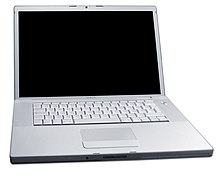
At the Worldwide Developers Conference keynote address on June 6, 2005, Jobs announced that Apple would move away from PowerPC processors, and the Mac would transition to Intel processors in 2006. On January 10, 2006, the new MacBook Pro and iMac became the first Apple computers to use Intel's Core Duo CPU. By August 7, 2006, Apple made the transition to Intel chips for the entire Mac product line—over one year sooner than announced. The Power Mac, iBook, and PowerBook brands were retired during the transition; the Mac Pro, MacBook, and MacBook Pro became their respective successors. Apple also introduced Boot Camp in 2006 to help users install Windows XP or Windows Vista on their Intel Macs alongside Mac OS X.
Apple's success during this period was evident in its stock price. Between early 2003 and 2006, the price of Apple's stock increased more than tenfold, from around $6 per share (split-adjusted) to over $80. When Apple surpassed Dell's market cap in January 2006, Jobs sent an email to Apple employees saying Dell's CEO Michael Dell should eat his words. Nine years prior, Dell had said that if he ran Apple he would "shut it down and give the money back to the shareholders".
2007–2011: Success with mobile devices

During his keynote speech at the Macworld Expo on January 9, 2007, Jobs announced the renaming of Apple Computer, Inc. to Apple Inc., because the company had broadened its focus from computers to consumer electronics. This event also saw the announcement of the iPhone and the Apple TV. The company sold 270,000 first-generation iPhones during the first 30 hours of sales, and the device was called "a game changer for the industry".
In an article posted on Apple's website on February 6, 2007, Jobs wrote that Apple would be willing to sell music on the iTunes Store without digital rights management, thereby allowing tracks to be played on third-party players if record labels would agree to drop the technology. On April 2, 2007, Apple and EMI jointly announced the removal of DRM technology from EMI's catalog in the iTunes Store, effective in May 2007. Other record labels eventually followed suit and Apple published a press release in January 2009 to announce that all songs on the iTunes Store are available without their FairPlay DRM.
In July 2008, Apple launched the App Store to sell third-party applications for the iPhone and iPod Touch. Within a month, the store sold 60 million applications and registered an average daily revenue of $1 million, with Jobs speculating in August 2008 that the App Store could become a billion-dollar business for Apple. By October 2008, Apple was the third-largest mobile handset supplier in the world due to the popularity of the iPhone.

On January 14, 2009, Jobs announced in an internal memo that he would be taking a six-month medical leave of absence from Apple until the end of June 2009 and would spend the time focusing on his health. In the email, Jobs stated that "the curiosity over my personal health continues to be a distraction not only for me and my family, but everyone else at Apple as well", and explained that the break would allow the company "to focus on delivering extraordinary products". Though Jobs was absent, Apple recorded its best non-holiday quarter (Q1 FY 2009) during the recession, with revenue of $8.16 billion and profit of $1.21 billion.
After years of speculation and multiple rumored "leaks", Apple unveiled a large screen, tablet-like media device known as the iPad on January 27, 2010. The iPad ran the same touch-based operating system as the iPhone, and all iPhone apps were compatible with the iPad. This gave the iPad a large app catalog on launch, though having very little development time before the release. Later that year on April 3, 2010, the iPad was launched in the U.S. It sold more than 300,000 units on its first day, and 500,000 by the end of the first week. In May 2010, Apple's market cap exceeded that of competitor Microsoft for the first time since 1989.
In June 2010, Apple released the iPhone 4, which introduced video calling using FaceTime, multitasking, and a new design with an exposed stainless steel frame as the phone's antenna system. Later that year, Apple again refreshed the iPod line by introducing a multi-touch iPod Nano, an iPod Touch with FaceTime, and an iPod Shuffle that brought back the clickwheel buttons of earlier generations. It also introduced the smaller, cheaper second-generation Apple TV which allowed the rental of movies and shows.
On January 17, 2011, Jobs announced in an internal Apple memo that he would take another medical leave of absence for an indefinite period to allow him to focus on his health. Chief operating officer Tim Cook assumed Jobs's day-to-day operations at Apple, although Jobs would still remain "involved in major strategic decisions". Apple became the most valuable consumer-facing brand in the world. In June 2011, Jobs surprisingly took the stage and unveiled iCloud, an online storage and syncing service for music, photos, files, and software which replaced MobileMe, Apple's previous attempt at content syncing. This would be the last product launch Jobs would attend before his death.
On August 24, 2011, Jobs resigned his position as CEO of Apple. He was replaced by Cook and Jobs became Apple's chairman. Apple did not have a chairman at the time and instead had two co-lead directors—Andrea Jung and Arthur D. Levinson—who continued with those titles until Levinson replaced Jobs as chairman of the board in November after Jobs's death.
2011–present: Post-Jobs era, Tim Cook
On October 5, 2011, Steve Jobs died, marking the end of an era for Apple. The next major product announcement by Apple was on January 19, 2012, when Apple's Phil Schiller introduced iBooks Textbooks for iOS and iBook Author for Mac OS X in New York City. Jobs stated in the biography Steve Jobs that he wanted to reinvent the textbook industry and education.
From 2011 to 2012, Apple released the iPhone 4s and iPhone 5, which featured improved cameras, an intelligent software assistant named Siri, and cloud-synced data with iCloud; the third- and fourth-generation iPads, which featured Retina displays; and the iPad Mini, which featured a 7.9-inch screen in contrast to the iPad's 9.7-inch screen. These launches were successful, with the iPhone 5 (released September 21, 2012) becoming Apple's biggest iPhone launch with over two million pre-orders and sales of three million iPads in three days following the launch of the iPad Mini and fourth-generation iPad (released November 3, 2012). Apple also released a third-generation 13-inch MacBook Pro with a Retina display and new iMac and Mac Mini computers.
On August 20, 2012, Apple's rising stock price increased the company's market capitalization to a then-record $624 billion. This beat the non-inflation-adjusted record for market capitalization previously set by Microsoft in 1999. On August 24, 2012, a US jury ruled that Samsung should pay Apple $1.05 billion (£665m) in damages in an intellectual property lawsuit. Samsung appealed the damages award, which was reduced by $450 million and further granted Samsung's request for a new trial. On November 10, 2012, Apple confirmed a global settlement that dismissed all existing lawsuits between Apple and HTC up to that date, in favor of a ten-year license agreement for current and future patents between the two companies. It is predicted that Apple will make US$280 million per year from this deal with HTC.
In May 2014, Apple confirmed its intent to acquire Dr. Dre and Jimmy Iovine's audio company Beats Electronics—producer of the "Beats by Dr. Dre" line of headphones and speaker products, and operator of the music streaming service Beats Music—for US$3 billion, and to sell their products through Apple's retail outlets and resellers. Iovine believed that Beats had always "belonged" with Apple, as the company modeled itself after Apple's "unmatched ability to marry culture and technology". The acquisition was the largest purchase in Apple's history.

During a press event on September 9, 2014, Apple introduced a smartwatch called the Apple Watch. Initially, Apple marketed the device as a fashion accessory and a complement to the iPhone, that would allow people to look at their smartphones less. Over time, the company has focused on developing health and fitness-oriented features on the watch, in an effort to compete with dedicated activity trackers. In January 2016, Apple announced that over one billion Apple devices were in active use worldwide.
On June 6, 2016, Fortune released Fortune 500, its list of companies ranked on revenue generation. In the trailing fiscal year of 2015, Apple was listed as the top tech company. It ranked third, overall, with US$233 billion in revenue. This represents a movement upward of two spots from the previous year's list.
In June 2017, Apple announced the HomePod, its smart speaker aimed to compete against Sonos, Google Home, and Amazon Echo. Toward the end of the year, TechCrunch reported that Apple was acquiring Shazam, a company that introduced its products at WWDC and specializing in music, TV, film and advertising recognition. The acquisition was confirmed a few days later, reportedly costing Apple US$400 million, with media reports that the purchase looked like a move to acquire data and tools bolstering the Apple Music streaming service. The purchase was approved by the European Union in September 2018.
Also in June 2017, Apple appointed Jamie Erlicht and Zack Van Amburg to head the newly formed worldwide video unit. In November 2017, Apple announced it was branching out into original scripted programming: a drama series starring Jennifer Aniston and Reese Witherspoon, and a reboot of the anthology series Amazing Stories with Steven Spielberg. In June 2018, Apple signed the Writers Guild of America's minimum basic agreement and Oprah Winfrey to a multi-year content partnership. Additional partnerships for original series include Sesame Workshop and DHX Media and its subsidiary Peanuts Worldwide, and a partnership with A24 to create original films.
During the Apple Special Event in September 2017, the AirPower wireless charger was announced alongside the iPhone X, iPhone 8, and Watch Series 3. The AirPower was intended to wirelessly charge multiple devices, simultaneously. Though initially set to release in early 2018, the AirPower would be canceled in March 2019, marking the first cancellation of a device under Cook's leadership. On August 19, 2020, Apple's share price briefly topped $467.77, making it the first US company with a market capitalization of US$2 trillion.
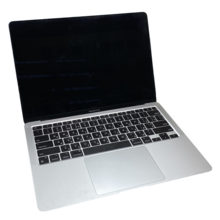
During its annual WWDC keynote speech on June 22, 2020, Apple announced it would move away from Intel processors, and the Mac would transition to processors developed in-house. The announcement was expected by industry analysts, and it has been noted that Macs featuring Apple's processors would allow for big increases in performance over current Intel-based models. On November 10, 2020, the MacBook Air, MacBook Pro, and the Mac Mini became the first Macs powered by an Apple-designed processor, the Apple M1.
In April 2022, it was reported that Samsung Electro-Mechanics would be collaborating with Apple on its M2 chip instead of LG Innotek. Developer logs showed that at least nine Mac models with four different M2 chips were being tested.
The Wall Street Journal reported that Apple's effort to develop its own chips left it better prepared to deal with the semiconductor shortage that emerged during the COVID-19 pandemic, which led to increased profitability, with sales of M1-based Mac computers rising sharply in 2020 and 2021. It also inspired other companies like Tesla, Amazon, and Meta Platforms to pursue a similar path.
In April 2022, Apple opened an online store that allowed anyone in the U.S. to view repair manuals and order replacement parts for specific recent iPhones, although the difference in cost between this method and official repair is anticipated to be minimal.
In May 2022, a trademark was filed for RealityOS, an operating system reportedly intended for virtual and augmented reality headsets, first mentioned in 2017. According to Bloomberg, the headset may come out in 2023. Further insider reports state that the device uses iris scanning for payment confirmation and signing into accounts.
On June 18, 2022, the Apple Store in Towson, Maryland, became the first to unionize in the U.S., with the employees voting to join the International Association of Machinists and Aerospace Workers.
On July 7, 2022, Apple added Lockdown Mode to macOS 13 and iOS 16, as a response to the earlier Pegasus revelations; the mode increases security protections for high-risk users against targeted zero-day malware.
Apple launched a buy now, pay later service called 'Apple Pay Later' for its Apple Wallet users in March 2023. The program allows its users to apply for loans between $50 and $1,000 to make online or in-app purchases and then repaying them through four installments spread over six weeks without any interest or fees.
In November 2023, Apple agreed to a $25 million settlement in a U.S. Department of Justice case that alleged Apple was discriminating against U.S. citizens in hiring. Apple created jobs that were not listed online and required paper submission to apply for, while advertising these jobs to foreign workers as part of recruitment for PERM.
In January 2024, Apple announced compliance with the European Union's competition law, with major changes to the App Store and other services, effective on March 7. This enables iOS users in the 27-nation bloc to use alternative app stores, and alternative payment methods within apps. This adds a menu in Safari for downloading alternative browsers, such as Chrome or Firefox.
In June 2024, Apple introduced Apple Intelligence to incorporate on-device artificial intelligence capabilities.
On November 1, 2024, Apple announced its acquisition of Pixelmator, a company known for its image editing applications for iPhone and Mac. Apple had previously showcased Pixelmator's apps during its product launches, including naming Pixelmator Pro its Mac App of the Year in 2018 for its innovative use of machine learning and AI. In the announcement, Pixelmator stated that there would be no significant changes to its existing apps following the acquisition.
On December 31, 2024, a preliminary settlement was filed in the Oakland, California federal court that accused Apple of unlawfully recording private conversations through unintentional Siri activations and shared them with third parties, including advertisers. Apple agreed to a $95 million cash settlement to resolve this lawsuit in which its Siri assistant violated user privacy. While denying any wrongdoing, Apple settled the case, allowing affected users to potentially claim up to $20 per device. Attorneys sought $28.5 million in fees from the settlement fund.
Products
Since the company's founding and into the early 2000s, Apple primarily sold computers, which are marketed as Macintosh since the mid-1980s. Since then, the company has expanded its product categories to include various portable devices, starting with the now discontinued iPod (2001), and later with the iPhone (2007) and iPad (2010). Apple also sells several other products that it categorizes as "Wearables, Home and Accessories", such as the Apple Watch, Apple TV, AirPods, HomePod, and Apple Vision Pro.
Apple devices have been praised for creating a cohesive ecosystem when used in conjunction with other Apple products, though have received criticism for not functioning as well or with as many features when used with competitive devices and instead often relying on Apple's proprietary features, software, and services to work as intended by Apple, an approach often described as "walled garden". As of 2023, there are over 2 billion Apple devices in active use worldwide.
